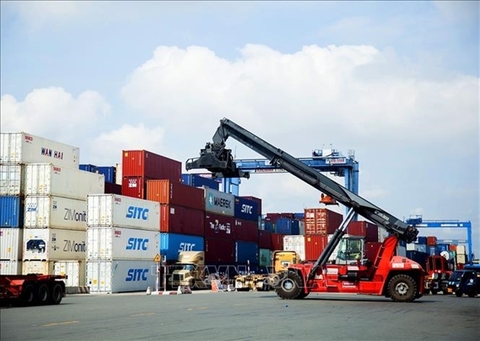Viet Nam to experience import, export difficulties by end of year: MoIT
Viet Nam to experience import, export difficulties by end of year: MoIT
Viet Nam's import and export activities will face many difficulties and challenges in the last months of this year and into the next, according to Nguyen Cam Trang, deputy director of the Import-Export Department, the Ministry of Industry and Trade (MoIT).

Good supply disruptions and high input material prices for production make many major economies in the world, such as the US and EU, forecast challenges and risk falling into recession.
High inflation in markets, especially the main export markets of Viet Nam, also reduces the demand for consumer goods.
Meanwhile, consumer goods are essential export products of Viet Nam, such as textiles, footwear, and furniture. Therefore, those would also directly affect the export growth trend of these products shortly, Trang said.
BIDV Securities Joint Stock Company (BSC) has also stated that the growth rate of import and export slows down when the consumption of the American people has a downtrend amid a sharp increase in interest rates.
BSC offers two scenarios based on the possibility of a recession in the world's largest economy.
In the first scenario, if the US has an economic recession in 2022, Viet Nam could increase exports by 13.1 per cent and imports by 12.6 per cent.
In the second, if the US faces an economic recession in 2023, Viet Nam could increase exports by 18 per cent and imports by 17.3 per cent.
In the latest report, Rong Viet Securities (VDSC) said there are many concerns to the domestic economy in the fourth quarter because the Fed has continued tightening monetary policy, leading to increasing discussion about risks of economic recession in the US.
Meanwhile, the European market is likely to deteriorate as the energy crisis increases in the winter.
Therefore, VDSC experts forecast that industrial production and export growth will slow down in the fourth quarter, but the level of decline will be moderate.
In addition, Trang has also pointed out that China is both a raw material supply market and a large export market for Viet Nam. Therefore, China's maintenance of strict measures to prevent and control the COVID-19 pandemic also affects the export activities and the supply of raw materials for Viet Nam and Viet Nam's goods exports to the world.
However, with participation in bilateral and multilateral Free Trade Agreements (FTAs) and experiences in trade activities, Viet Nam may limit risks in exports.
The positive export results of the first nine months will support Viet Nam to reach the target on import and export in 2022 and even exceed the set targets.
In this context, Trang has recommended that businesses proactively update information about the world and import markets. Since then, they have changed management policies, production and business plans. At the same time, they should plan to diversify export and import markets.
"With many solutions, the Ministry of Industry and Trade always accompanies businesses, especially the system of Viet Nam trade offices abroad and the early warning system. They will promptly provide information on the market, helping the enterprises to soon diversify export and import markets towards the sustainable development of exports and imports," Trang said.
She said that import and export continued to be a bright spot in Vietnam's economic picture in the first nine months of 2022, with export value at an increase of 17.2 per cent to US$282 billion. As a result, the nation gained a trade surplus of over $6.8 billion.
The export growth of product groups, enterprise sectors, and markets was similar and stable. For example, the group of agriculture, forestry and fishery increased by nearly 15 per cent, while the group of processing industry rose by 17 per cent.
Meanwhile, the export growth also reached 15 per cent for domestic enterprises and 17 per cent for foreign direct investment (FDI) enterprises.
Notably, in the first nine months of 2022, Viet Nam's exports recorded double-digit growth in many markets, especially those with free trade agreements (FTAs) with Viet Nam, such as Canada, South Korea and Japan.
In the first nine months of 2022, the nation saw a trade surplus of $6.8 billion, and some major export markets still recorded positive growth figures against the same period of last year.
However, in September, export growth slowed and the growth rate decreased by 14 per cent compared to the previous month, mainly in electronics, computers and phones. Therefore, the growth rate in the third quarter also decreased against the previous quarter.
It should be noted that the third quarter is usually a quarter with a high trade surplus and contributes most to the trade surplus.



















